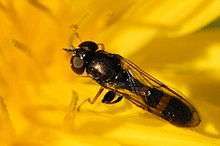Neoascia podagrica
| Neoascia podagrica | |
|---|---|
 | |
| Scientific classification | |
| Kingdom: | Animalia |
| Phylum: | Arthropoda |
| Class: | Insecta |
| Order: | Diptera |
| Family: | Syrphidae |
| Genus: | Neoascia |
| Subgenus: | Neoascia |
| Species: | N. podagrica |
| Binomial name | |
| Neoascia podagrica (Fabricius, 1775) | |
| Synonyms | |
Neoascia podagrica is a species of hoverfly.[1][2]
Description
External images
For terms see Morphology of Diptera
Metapleurae form a continuous band behind coxae 3. Antennomere 3 twice as long as broad and wing veins tm and tp brownish.Male tergite with straight yellow band.
The larva is figured by Hartley (1961) [3]The male genitalia are illustrated by Barkemeyer and Claussen (1986) [4]
See references for determination.[5] [6] [7] [8]
Distribution
Palearctic Fennoscandia South to Iberia Mediterranean basin East through North Europe, Central Europe and South Europe (Italy, the former Yugoslavia, Greece) to Turkey and Israel, European Russia into Siberia as far as Lake Baikal. [9] [10]
.jpg)
Biology
Habitat: wetlands and alluvial forest , pond margins and fen, wet pasture, along wet ditches, around farmyards, canal banks, suburban gardens, rubbish dumps and parks.[11]Flowers visited include white umbellifers, Achillea millefolium, Allium ursinum, Caltha, Chelidonium, Convolvulus, Crataegus, Euphorbia, Leontodon, Menyanthes, Plantago,Potentilla erecta, Ranunculus, Salix repens, Senecio jacobaea, Taraxacum. [12] The flight period is April to October.The larva issub-aquatic, occurring in cow-dung, slurry and dung-enriched mud.
References
- ↑ Stubbs, Alan E.; Falk, Steven J (1983). British Hoverflies: An Illustrated Identification Guide (2nd ed.). London: British Entomological and Natural History Society. pp. 253, xvpp. ISBN 1-899935-03-7.
- ↑ Ball, S.G.; Morris, R.K.A. (2000). Provisional atlas of British hoverflies (Diptera, Syrphidae). Monks Wood, UK: Biological Record Centre. pp. 167 pages. ISBN 1-870393-54-6.
- ↑ Hartley, J.C. (1961) A taxonomic account of the larvae of some British Syrphidae. Proc.zool.Soc.Lond.,136: 505-573.
- ↑ Barkemeyer, W. & Claussen, C. (1986) Zur Identitat von Neoascia unifasciata (Strobl 1898): mit einem Schlussel fur die in der Bundesrepublik Deutschland nachgewiesenen Arten der Gattung Neoascia Williston 1886 (Diptera: Syrphidae). Bonn.zool.Beitr., 37: 229-239.
- ↑ Van Veen, M. (2004) Hoverflies of Northwest Europe: identification keys to the Syrphidae. 256pp. KNNV Publishing, Utrecht.addendum
- ↑ Van der Goot,V.S. (1981) De zweefvliegen van Noordwest - Europa en Europees Rusland, in het bijzonder van de Benelux. KNNV, Uitgave no.32: 275pp. Amsterdam.
- ↑ Bei-Bienko, G.Y. & Steyskal, G.C. (1988) Keys to the Insects of the European Part of the USSR, Volume V: Diptera and Siphonaptera, Part I. Amerind Publishing Co., New Delhi. ISBN 81-205-0080-6.
- ↑ Coe, R.L. (1953) Diptera: Syrphidae. Handbks.ident.Br.insects, 10(1): 1-98. R.ent.Soc.London. pdf
- ↑ Fauna Europaea
- ↑ Peck, L.V. (1988) Syrphidae. In: Soos, A. & Papp, L. (eds.) Catalogue of Palaearctic Diptera, 8: 11-230. Akad.Kiado, Budapest.
- ↑ Speight, M.C.D. (2011). "Species accounts of European Syrphidae (Diptera)" (PDF). Syrph the Net, the database of European Syrphidae. 65: 285pp.
- ↑ de Buck, N. (1990) Bloembezoek en bestuivingsecologie van Zweefvliegen (Diptera, Syrphidae) in het bijzonder voor België. Doc.Trav. IRSNB, no.60, 1-167.